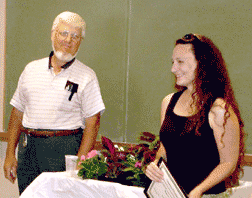|
|||||||||||
|
|||||||||||
Bay Gardener Cultivates Future HorticulturalistsPaying it forward to figure out our living world
Back in 1960, the Bay Gardener got a green start with a National Science Foundation Undergraduate Grant of $250. With this money — which went a lot further in those days — I studied the effects of hormones on the rooting of mountain laurel and rhododendron cuttings, one of many experiences that encouraged me to pursue a career in teaching, research and extension. These days, I’m paying it forward with the Francis R. Gouin Undergraduate Research Grant, funded by payment from creating this Bay Gardener column each week, writing for trade journals and association newsletters and presenting at area lectures. In lieu of accepting an honorarium, all I earn is sent directly to the University of Maryland and invested in a special fund. Since retiring in 1995, I’ve raised more than $30,000. Beginning last year, we awarded $2,000 grants to a junior majoring in horticulture or plant science. To try for the grant, students submit a research proposal to the Department of Plant Science and Landscape Architecture, which selects the proposal most likely to succeed and to be completed in less than one year. The winner gets $1,000 to cover research labor. The remaining $1,000 covers expenses at a regional or national meeting of a professional plant science society where the winner presents the results of the experiment. This year’s winner is Demetra Skaltsas, a Marylander born in Greece. Skaltsas recently earned an associate in arts degree in life sciences from Howard Community College; she will be receiving her bachelor of science degree in plant science from the University of Maryland this fall. The first $1,000 of the grant will help her research differences in the gram negative bacteria that cause fire blight in apples and pears. Fireblight is a very destructive disease caused by the bacteria Erwinia amylovora entering the plant through the blossoming flowers in the spring. Early research has found that chemical control of fireblight results in three times more gram negative bacteria than when organic controls are used. Skaltsas’ research will focus on finding a relationship between treatment methods and bacterial counts of Erwinia amylovora. Some varieties of apples and pears are much more susceptible to fireblight than others. To stay in control, an orchardist must spray susceptible species with Aggromycian when the trees are in full bloom. When flowering occurs during prolonged periods of rain, the grower has little to no control. Since the disease affects some of the most popular varieties — like Gala and Fuji apples and Bartlett pears — finding a predictable cure for this disease will get better fruit into our hands and on the table. Ask Dr. Gouin your questions at [email protected]. All questions will appear in Bay Weekly. Please include your name and address. |
|||||||||||
|
|||||||||||
|
|
|||||||||||
|
© COPYRIGHT 2007 by New Bay Enterprises, Inc. All rights reserved.
|
|||||||||||


